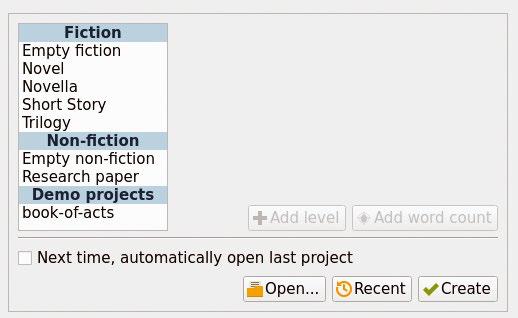
Have you ever wanted to write a novel, an essay, or anything more complex than a school report? In this tutorial, I explain a technique for organizing your writing project efficiently: the snowflake method. I'll also introduce you to Manuskript [1], a multi-platform, open source tool you can use for implementing the snowflake method for your own writing work, made to order for it. The goal of Manuskript is to help writers "create their first draft and then further refine and edit their masterpiece."
The snowflake method, which was created by Randy Ingermanson, sits in the middle between adhering to a complete, traditional outline and "freewriting," or deliberately writing without any plan, which can facilitate discovery but is also sometimes very unproductive.
Details and tips about the snowflake method are available online [2] [3], but the concept is extremely simple: Start with a really basic story summary and add little elements to it in a circular, incremental way, just like particles of ice attach to each other to form complex snowflakes. In other words, start by writing down the basic idea of the book, then the main character or characters, and then the setting using just one sentence for each entry.
Then you go back to the description and transform it into three very short paragraphs that outline the beginning, middle, and end of the story. Next you write equally short descriptions of each main character, or add minor ones, then expand the description of the setting in the same way, adding details to every description until you have all you need to actually write your story.
Installation
هذه القصة مأخوذة من طبعة #262/September 2022 من Linux Magazine.
ابدأ النسخة التجريبية المجانية من Magzter GOLD لمدة 7 أيام للوصول إلى آلاف القصص المتميزة المنسقة وأكثر من 9,000 مجلة وصحيفة.
بالفعل مشترك ? تسجيل الدخول
هذه القصة مأخوذة من طبعة #262/September 2022 من Linux Magazine.
ابدأ النسخة التجريبية المجانية من Magzter GOLD لمدة 7 أيام للوصول إلى آلاف القصص المتميزة المنسقة وأكثر من 9,000 مجلة وصحيفة.
بالفعل مشترك? تسجيل الدخول

MADDOG'S DOGHOUSE
The stakeholder approach of open source broadens the pool of who can access, influence, and benefit from information technologies.

MakerSpace
Rust, a potential successor to C/C++, claims to solve some memory safety issues while maintaining high performance. We look at Rust on embedded systems, where memory safety, concurrency, and security are equally important

In Harmony
Using the Go Interface mechanism, Mike demonstrates its practical application with a refresh program for local copies of Git repositories.

Monkey Business
Even small changes in a web page can improve the browsing experience. Your preferred web browser provides all the tools you need to inject JavaScript to adapt the page. You just need a browser with its debugging tools, some knowledge of scripting, and the browser extension Tampermonkey.

Smarter Navigation
Zoxide, a modern version of cd, lets you navigate long directory paths with less typing.

Through the Back Door
Cybercriminals are increasingly discovering Linux and adapting malware previously designed for Windows systems. We take you inside the Linux version of a famous Windows ransomware tool.

Page Pulse
Do you want to be alerted when a product is back in stock on your favorite online store? Do you want to know when a website without an RSS feed gets an update? With changedetection.io, you can stay up-to-date on website changes.

Arco Linux
ArcoLinux, an Arch derivative, offers easier installs while educating users about Arch Linux along the way.

Ghost Coder
Artificial intelligence is increasingly supporting programmers in their daily work. How effective are these tools? What are the dangers? And how can you benefit from Al-assisted development today?

Zack's Kernel News
Chronicler Zack Brown reports on the latest news, views, dilemmas, and developments within the Linux kernel community.